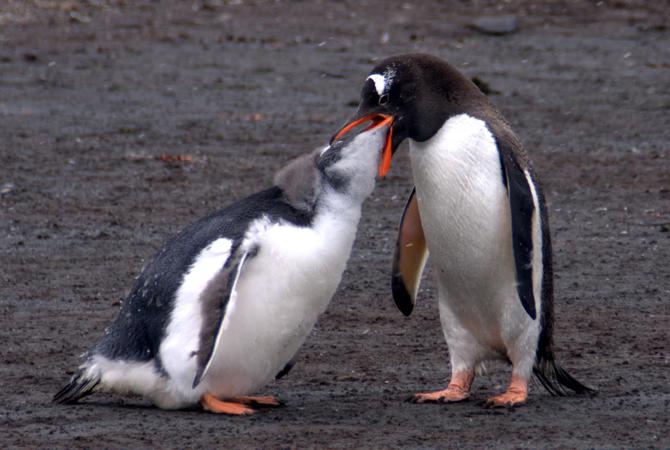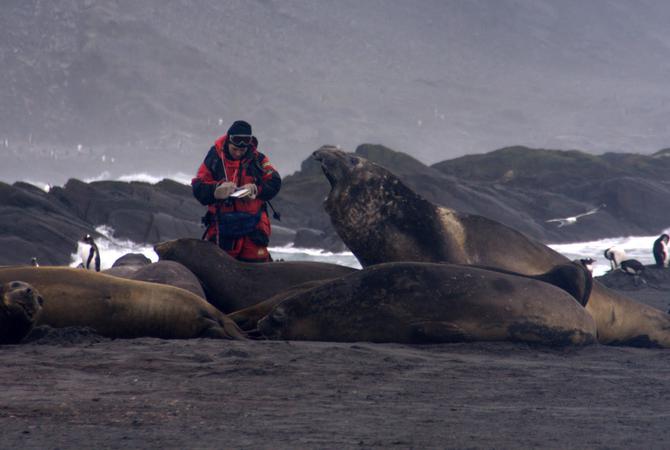Nature has dished up some pretty extreme milks over the course of evolution, but hooded seal milk is in a league of its own.
While human breast milk contains a relatively modest amount of fat (between three and five per cent), hooded seal milk contains a whopping 60 per cent fat, making it the fattiest milk known to science.
So why do seals need such extreme milk?
That’s a question for Professor Mark Hindell from the University of Tasmania , whose research is focussed on understanding the pressures faced by warm-blooded animals living in polar regions.
Fat for babies
Hooded seals (Cystophora cristata) give birth on transient sea-ice in the Arctic, Hindell says, and that means they have very limited time to prepare their pups for life in the ocean. In fact, they take less than five days to do so, which makes theirs the shortest weaning period of any known mammal.
Shortly after birth, seal mums feed their pups almost eight litres of milk a day, causing the pups to double in size and pack on a thick layer of blubber to insulate them in the chilly waters of the Arctic and North Atlantic Oceans.
At the other end of the planet in the Southern Ocean, elephant seals (Mirounga leonina) have a similar strategy, but they give birth on sub-Antarctic islands instead of floating sea-ice, so they’ve got a whole lot more time to fatten up their pups.
During the first 20 days of lactation, the fat content of elephant seal milk increases from 12 to 52 per cent, and it turns into a thick, pudding-like consistency. This helps the pups quadruple their birth weight to around 135 kg within just four weeks of birth.
In order to survive, the resident seals, penguins, and whales have all come up with the same solution – fat.

Credit: Mark Hindell.
“The performance of a population is all mediated by how much fat they can put on,” Professor Hindell said. “We’re looking at how animals gather resources and use those resources to go about their daily business.”
Certain factors can simultaneously help and hinder different species, depending on their breeding behaviours, he says. “A lot of animals need to build up their energy reserves, because it's very expensive to make babies and suckle or feed them.”
“Most animals do that by putting on fat, and the fatter you are, the more likely you are to raise healthy offspring.”
Fat vs blubber
When you’re living in sub-zero temperatures, you need to able to accumulate large amounts of fat and blubber for insulation, energy storage, and buoyancy.
Fat and blubber might seem like interchangeable terms, but they’re actually different types of tissue that work in tandem with each other to protect warm-blooded species in extreme environments.
The main differences between fat and blubber are their consistency and blood supply – blubber contains many more blood vessels than fat, and is far more dense because it’s made up of a mix of collagen fibres and lipids.
Blubber layers can be incredibly thick. Polar bears sport 10 cm of the stuff under two coats of fur, while the blubber layer in bowhead whales (Balaena mysticetus) can be as thick as half a metre.
The thickness and density of blubber makes it far more effective than fat at protecting warm-blooded animals from the cold and, because it sits directly under the skin, it can even cushion them against cuts and violent blows.
Blubber is also crucial for buoyancy, which makes it a major energy-saver for animals that spend a lot of time in the water. Why swim when you can float?

Researchers from the University of Tasmania are monitoring populations of Antarctic seals to keep track of their numbers. Credit: Mark Hindell.
Maintaining the bulk
To ensure that seal babies double or even quadruple their weight fast enough to survive in sub-zero temperatures, mother seals have to tap into a large enough energy supply to get through the weaning period.
The challenge for researchers investigating why certain populations struggle to maintain their fat supply is that there are many different factors at play – and some can mean life for one species, and death for another.
Back in the 1980s, Hindell and his team noticed that the elephant seal population on Macquarie Island, about 2,000 kilometres south of Australia, had experienced a pronounced decline since the 1950s.
When they looked again at the trends this year, they found that the numbers had continued their steady decrease.
“When we first realised it in the 1980s, we had no idea what was driving it. Back then, there was no satellite tracking,” he said.
“We put out some of the first ever satellite tracking on marine animals, because we needed to know where they went, what they were feeding on, and the effects of climate change on their food supply.”
Thanks to this new satellite system, Professor Hindell and his team discovered that at the same time as the population decline on Macquarie Island, there was an abundance of sea-ice.
That might seem counterintuitive, because a thick cover of sea-ice means the effects of climate change aren’t as severe as they are elsewhere in polar regions.
But it turns out that a rare silver lining in our dangerously warming planet is that elephant seals appear to fare better when the sea-ice is scarce, because it gives them more room to forage for prey such as squid and fish.
“Elephant seals actually do less well when sea-ice is abundant,” Professor Hindell said. “The oceans south of Macquarie Island actually experienced an increase of ice over the last few decades, so the mothers came back thinner, the pups weren’t as big, and don’t survive as well.”
“In some ways, elephant seals will be winners in the climate change story – they will actually increase their foraging success,” he said.
Not all good news
But elephant seals are the exception to the rule, because many other species are struggling to survive as the sea-ice melts.
Hooded seals are at serious risk because of their reliance on sea-ice for birthing and weaning their pups, and researchers have found that baby harp seals, which are also born on floating ice, are drowning or being crushed to death as the ice breaks up into fast-moving chunks.
Emperor penguins are also in trouble, Professor Hindell said. “Emperor penguins are a weird species that breeds in the middle of winter, so they need the sea-ice.”
Even for species that don’t need sea-ice for breeding, climate change is expected to leave its mark. Research coming out of Professor Hindell’s team now suggests that even whales could struggle to maintain their fat levels as the planet gets warmer.
“This may well be a group of animals that loses out,” he said.
By Bec Crew.
Keen to conduct your own research? Apply now to become a research student.